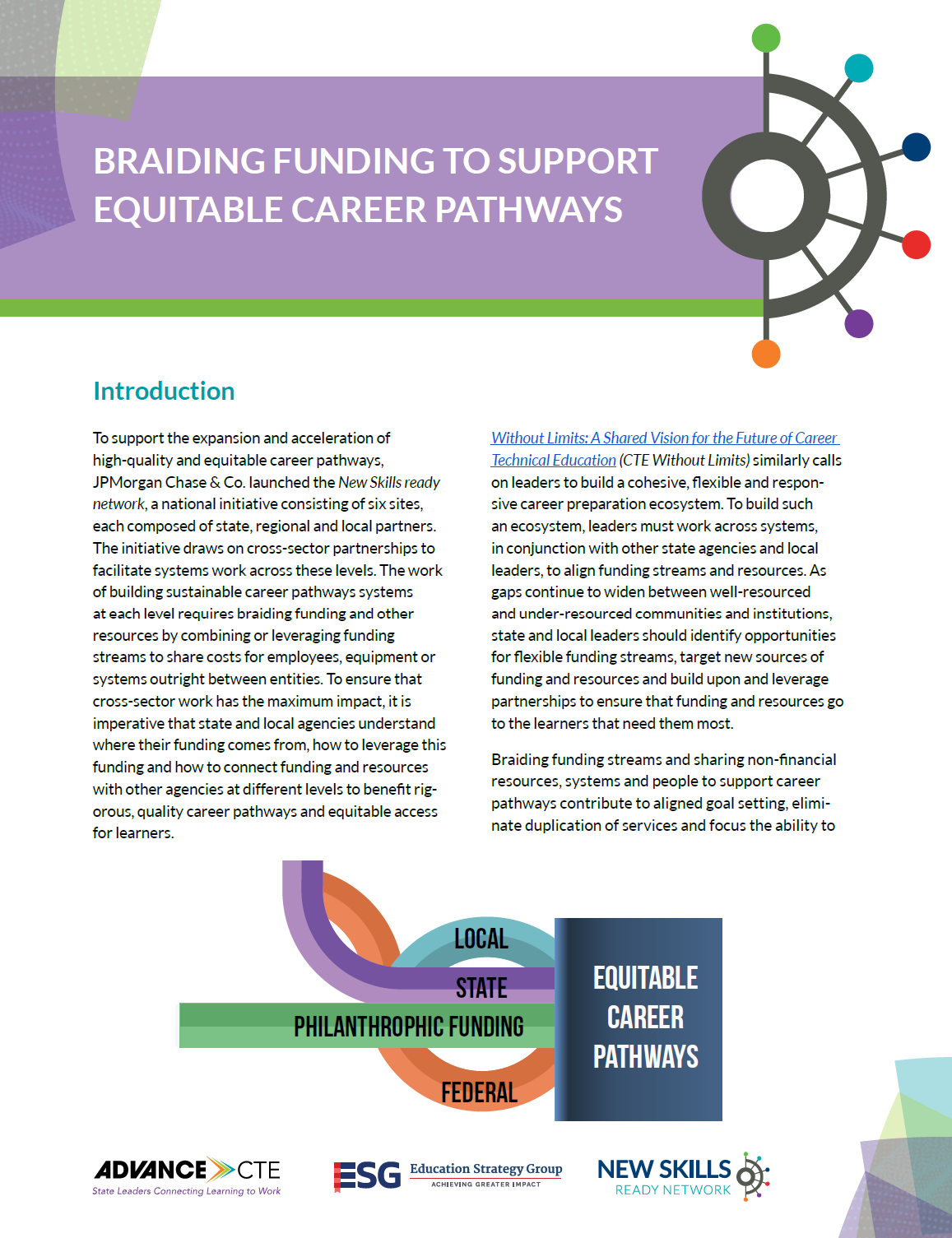Without Limits: A Shared Vision for the Future of Career Technical Education (CTE Without Limits) calls on leaders to build a cohesive, flexible and responsive career preparation ecosystem and work across systems to align funding streams and resources. One initiative Advance CTE is supporting to advance this work is the New Skills ready network, a JPMorgan Chase & Co. funded initiative, which draws on cross-sector partnerships in six cities, each composed of state, regional and local partners. This work of building sustainable, equitable career pathways systems at each level requires braiding funding and other resources by combining or leveraging funding streams to share costs for employees, equipment or systems outright between entities. As gaps continue to widen between well-resourced and under-resourced communities and institutions, state and local leaders should identify opportunities for flexible funding streams, target new sources of funding and resources and build upon and leverage partnerships to ensure that funding and resources go to the learners that need them most.
 In support of this effort, Advance CTE recently published Braiding Funding to Support Equitable Career Pathways, which also includes key steps to effectively braiding funds and resources. Here are some examples of promising practices from states, how they align with CTE Without Limits and considerations states can take to implement this type of practice in their own state.
In support of this effort, Advance CTE recently published Braiding Funding to Support Equitable Career Pathways, which also includes key steps to effectively braiding funds and resources. Here are some examples of promising practices from states, how they align with CTE Without Limits and considerations states can take to implement this type of practice in their own state.
- One foundation of CTE Without Limits is a commitment to meaningful public/private partnerships with industry partners deeply invested and involved in the design, delivery and success of the CTE system. Delaware leverages these types of partnerships and their connected funding streams through Delaware Pathways, which coordinates and organizes education and workforce development systems for youth and adult learners. Because this initiative brings together dozens of national, state and local partners, a named priority of the strategic plan is to coordinate financial support for career pathways and to braid funding to ensure long-term success. Recently, the state used ESSER funds braided with GEER and philanthropic funds to help launch a $15.8 million expansion called Delaware Pathways 2.0. The investment will reach 6,000 middle school learners and more than 12,000 additional secondary learners and specifically targets career pathways in health care, information technology, finance and engineering. As states consider long-term program sustainability, they can institutionalize this type of stakeholder engagement and partnership and create champions to carry work through periods of transition.
- The first principle of CTE Without Limits calls for established shared, statewide goals for a cohesive career preparation ecosystem. Alabama aligned multiple agencies and initiatives around Governor Kay Ivey’s goals for education and workforce development. The Governor’s Office of Education and Workforce Development, the Alabama Department of Labor, the Alabama Workforce Council, and the Alabama Department of Education partner on and financially support multiple initiatives, including a statewide longitudinal data system and alignment around equity and access goals. Braiding funding and resources requires political will and support from leadership across the spectrum, including state and local administrators. This alignment was organized through legislative support and gubernatorial direction for initiatives that can affect the futures of all Alabamians. States can engage leaders at all levels to ensure consistency and credibility needed to achieve goals through a singular, coordinated effort.
- Another action step of Principle One of CTE Without Limits is that leaders must design equitable funding models that direct funding to where it is needed most. Underutilized federal funds like the U.S. Department of Health and Human Services’ Temporary Assistance for Needy Families (TANF) and the U.S. Department of Agriculture’s Supplemental Nutrition Assistance Program (SNAP) can be used to support adult education and workforce training programs. Arkansas uses SNAP and TANF funding in part to support its Career Pathways Initiative (CPI), which supports educational and workforce training while providing additional non-academic supports. The initiative requires coordination and support from the Arkansas Division of Higher Education (ADHE), the Arkansas Department of Workforce Services and the state’s 22 two-year colleges and three technical centers. ADHE directly allocates CPI funding to each of the institutions based on a formula of enrollment of students with low income, completion rates, credential attainment and employment outcomes. Since 2005, the Arkansas CPI has provided services to more than 30,000 qualifying students enrolled in career-oriented programs in community and technical colleges. With intentionality, states can ensure that funding goes toward the populations who most need the support to address opportunity gaps and increase access.
This resource is the fourth policy brief in the Strengthening Career Pathways series. For more resources on funding and high-quality career pathways, please visit the Learning that Works Resource Center.
Dan Hinderliter, Senior Policy Associate
Tags: Alabama, Arkansas, career pathways, Delaware, funding, Montana, New Skills ready network, Oklahoma

